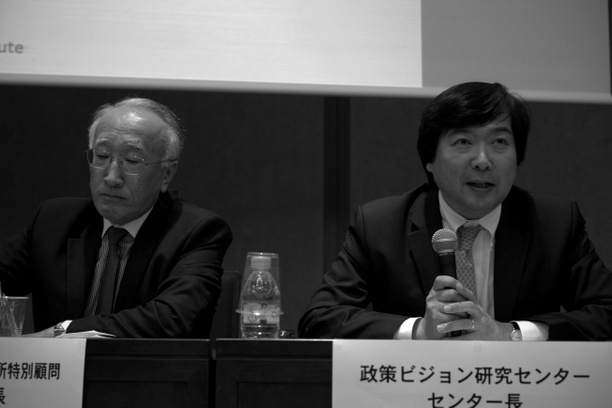The 6th Energy Policy Roundtable 2012 Report
Hisashi Yoshikawa
Professor, UTokyo Policy Alternatives Research Institute (PARI) / Graduate School of Public Policy (GraSPP), the University of Tokyo
Aug. 16, 2013
日本語ページへ
The 6th Energy Policy Roundtable 2012 Program
Energy Policy Roundtable 2012
Japan and Directions in World Energy Policy
| [Date] | Thursday, January 31, 13:20-15:30 (Hall opens at 12:50) |
|---|---|
| [Venue] | Ito Hall (B2 floor), Ito International Research Center |
| [Hosted by] | UTokyo Policy Alternatives Research Institute (PARI) |
| [Co-hosted by] | Graduate School of Public Policy (GraSPP) |
| Keynote Speech | |
|---|---|
| Dr. Fatih Birol | Chief Economist of the International Energy Agency (IEA), Director of the World Energy Outlook (WEO) Handout |
| Panel Discussion | |
| Mr. Nobuo Tanaka | Global Associate for Energy Security and Sustainability at the Institute of Energy, Economics, Japan (IEEJ) / the former Executive Director of the International Energy Agency (IEA) Handout |
| Prof. Hideaki Shiroyama | Director of UTokyo Policy Alternatives Research Institute (PARI), Vice Dean / Professor, Graduate School of Public Policy (GrasPP), the University of Tokyo Handout |
| Moderator | |
| Prof. Hisashi Yoshikawa | Professor, UTokyo Policy Alternatives Research Institute (PARI) / Graduate School of Public Policy (GraSPP), the University of Tokyo |

The 6th Energy Policy Roundtable was held on January 31st, 2013. For this final session of the roundtable seminar, which ran for a year, the keynote speaker of the first session, Dr. Fatih Birol, Chief Economist of the International Energy Agency (IEA), Director of the World Energy Outlook (WEO) was invited again to sum up the earlier discussions on various subjects related to energy and reconfirm the global energy situation, based on the latest information. Following Dr. Birol's keynote speech was a panel discussion joined by Global Associate for Energy Security and Sustainability at the Institute of Energy Economics, Japan and former Executive Director of IEA, Nobuo Tanaka, who has been a regular attendant of this roundtable throughout the year, and Professor Hideaki Shiroyama from the University of Tokyo Graduate School for Law and Politics (Director of UTokyo Policy Alternatives Research Institute, Vice Dean of Graduate School of Public Policy).
First, Dr. Birol's keynote speech is outlined as below:
The global energy structure is undergoing dynamic changes. Profound changes are taking place not only in the energy industry, economy and diplomatic policies, but are also affecting our personal lives. There are three key factors that are driving these changes. The first and foremost factor is that some nations including the United States are emerging as new major oil and gas producers. The second factor is that many nations including Germany, Switzerland and Japan are reorienting their policies on nuclear power since the disastrous incident in Fukushima. Even in France, which is heavily dependent on nuclear power, with 75% of its entire energy consumption reliant on this single source, President Franois Hollande promised to his people to lower the country's dependency on nuclear energy. The third factor, which is often overlooked, is energy efficiency. Up till recently, only a handful of nations such as Japan and the Scandinavian countries were seriously engaged in setting up policies to pursue more efficient ways of using energy. However, in the past few months, groundbreaking legislative action has been taken, for example, in the United States with newly enacted energy-related laws, in China under its new 5-year plan, as well as in the EU where a new directive on energy has been issued. These movements may finally give momentum to the currently stagnant efforts to improve energy efficiency in most parts of the world. Through these three main drivers, the world's energy landscape is about to change dramatically.

Dr. Fatih Birol
Meanwhile, although the oil price has risen to 115 dollars per barrel, which is considerably high, the world seems unconcerned. Last year, the average oil price reached a record-high of 112 dollars to a barrel. A high energy price is a negative factor for the world's economic recovery. A different phenomenon is occurring to the price of natural gas, where the price gap between regions is widening. Compared to the United States, the gas price in Europe is five times higher, and Asia is paying eight times more. For these two continents, this is a serious matter, especially from the standpoint of industrial competitiveness. In fact, the price of natural gas five years ago was more or less the same across these three regions. This is perhaps the first time for the regional disparity in the price of a commodity of such strategic importance to have grown so large.
When observing the world's energy situation from the standpoint of sustainability, we need to note that many emerging nations are spending a large amount of subsidies on fossil fuels, totaling around half trillion dollars or more, which is equivalent to 110 dollars or more per ton of CO2. In other words, these countries are encouraging their home industries and people to emit that much CO2 into the atmosphere. At present, in Europe, the carbon price is traded at about 10 dollars. If we combine the carbon pricing systems implemented in emerging nations and in Europe, alarmingly, the energy policies taken in these regions are, as a whole, giving an incentive to emit more carbon dioxide. As a matter of fact, last year's global total amount of CO2 emissions was the highest on record, as a result of which, in terms of CO2 emissions, the global temperature seems to be on a rising trend by six degrees celcius. Renewable energy is also currently facing a very difficult situation as a solution to prevent global warming, as the total amount of funds invested in the development of more renewables, which continued to expand from 2001 to 2011, began declining in 2012.
Currently, 1.3 billion people living mainly in regions and countries such as sub-Sahara Africa, India, Pakistan and Bangladesh still have no access to electricity. For example, the African population to the south of the Sahara Desert totals 800 million people. The potential amount of electricity consumption in this region is only equivalent to that of New York City.
Let us then take a look at the relationship between water and energy. Currently, 15% of water available in the world is used for generating energy, and this ratio is expected to rise considerably going forward, making water an increasingly valuable resource. More specifically, the planners of various energy projects will be forced to consider water as an extremely important factor in making their projects cost-effective. Not only will the cost be an issue, the planners will also have to think more seriously about how to secure a sufficient supply of water for their energy projects.

When the IEA was established, the amount of energy consumed by the member states of this new organization accounted for around 60% of total global energy consumption. Now, this ratio is down to about half (approx. 30%). The level of influence the IEA can exert as an important global energy control mechanism is therefore dependent on how successfully this international organ can build working relationships with emerging countries. One thing is certain, the center of gravity of energy demand in the world is gradually shifting toward the East.
In the United States, conventional petroleum production is decreasing year after year, while non-conventional petroleum production is on the rise, thanks to the implementation of new technology. By around 2017, the US is expected to seize the top position currently held by Saudi Arabia and become the world's largest oil producer. Likewise with natural gas, conventional gas production has been continuing its downward trend in the United States where the so-called “shale revolution” is boosting the expansion of non-conventional gas production. And by around 2015, the United States is expected to surpass Russia and become the largest gas producer in the world. In other words, within the next ten years and potentially much earlier than that, the United States will emerge as the world leader in both oil and gas production. Until recently, this country was importing a fairly large amount of petroleum from the Middle East. It may be unrealistic to predict that the United States will stop importing oil completely in the near future, but from here onward, it is quite likely that its volume of imported oil will be reduced to the minimum required. If the United States shifts its energy procurement policy in this direction, it will have a major impact on the world beyond the domain of energy. When the United States was still a major oil importer, the eastbound and westbound exports of petroleum from the Middle East were more or less balanced, But once exports to the United States drop sharply as predicted, the Middle-Eastern oil producers will soon be shipping 90% of their petroleum to Asia, which means that the export of oil from the Gulf nations to China, India and the member states of ASEAN will rapidly increase in the foreseeable future.
Among the Gulf nations, energy trends in Iraq is noteworthy. In the Middle East, Iraq is not only blessed with a wealth of both oil and gas resources, it can also supply them at very low production cost. The production cost of Iraqi oil per barrel is only one fifteenth of that of American oil from non-conventional sources, and one-eleventh of that of Russian oil. However, for the international community, there are many challenges to overcome, regarding access to this cheap and abundant Iraqi oil. Such challenges include the fact that 30% of oil fields in Iraq are directly or indirectly owned by Chinese firms that already hold considerable interests in this country, and the prospect that the relationship between Baghdad and Beijing as well as the business-to-business (BtoB) ties between the private sectors of Iraq and China will continue to deepen.
Regarding the international market for natural gas, the trading up till now has been limited. However, the shale revolution is likely to change the status quo dramatically, motivating the shale gas owners to explore new export routes aggressively. The shale revolution has had a large impact on countries and people around the world. It has created new winners, losers and in-betweens. The winners are obviously the ones that have shale gas reserves embedded within their borders, which are the United States, Canada and Australia. The losers are the traditional gas exporters, which have lost their competitiveness in terms of both the price and volume. The in-betweens are the nations that have the potential to become winners if they succeed in revising the price agreed with the gas importers in their favor and reflecting the reduced purchase cost on their domestic consumer price.

Another issue that is drawing a lot of attention is energy security. The amount of oil and gas that can be imported is a matter of significant interest for the economy, foreign diplomacy and national security of any country. For example, Beijing is very concerned about relying on imports for 15% of gas and 50% of petroleum used domestically. In the National Congress of the Communist Party of China convened last year-end, energy security was included as one of the three key strategic challenges that need to be addressed. While the amount of imported oil and gas is increasing in many countries, the United States has become a sole exception by turning into a gas exporter and a minimal oil importer.
The United States achieved this transformation by successfully increasing its domestic production of oil and gas and by reducing its domestic consumption of petroleum. The latter success owes largely to the establishment of fuel efficiency criteria for automobiles and trucks that were implemented as one of the new energy policies set forth during the first term of the Obama administration. In the United States, an average automobile consumes 9 liters of gasoline to run 100 kilometers, whereas it consumes 6 liters in Europe and 5.5 liters in Japan. Although the United States is still far behind Europe and Japan in average fuel efficiency, the domestic consumption of petroleum was successfully curbed under President Obama's leadership.
Regarding the energy sources used for power generation, Japan has increased the proportion of gas and renewable energy, while the member states of ASEAN are still using a large amount of coal. In the United States, the use of coal decreased and the use of renewable energy sources increased. However, whether this trend continues depends on how long the federal government is going to continue supporting the domestic renewable energy development projects with subsidies. India is rapidly increasing the total amount of energy supplied domestically, but about 50% is still sourced from coal. This country is now the world's second largest coal importer after China, and is also expected to exceed China and become the world's largest, sooner or later. China's domestic demand for power generation facilities is expanding increasingly. The number of greenfield projects planned in China to construct enormous power stations is expected to increase, but even its plans to expand the existing facilities alone match the current total capacity of power generation plants operating in the United States and Japan combined. We are entering an era where whatever China decides to do is going to affect the rest of the world. Even in terms of energy policy, China is essentially the only nation in the world today that has the power and privilege of making history.
As far as the amount of subsidies invested in promoting the development of more renewable energy is concerned, the world is currently spending 88 billion dollars per year and the cumulative total has now reached 5 trillion dollars.

There are two areas that are being affected greatly by the dynamic changes occurring in the global energy situation as mentioned in the beginning of this speech. One is the impact on the geopolitical balance between energy consumers and suppliers, especially how the United States will affect the global energy landscape as the major supplier of energy resources. The second point is the impact of industrial competitiveness. When we look at the price of electricity in various parts of the world, we see that there is a significant difference between the major players, which are namely the United States, China, the EU and Japan. The former two manage to generate electricity at low cost, while the latter two have to cope with high cost. This large difference in cost is affecting the competitiveness of the industries in each country or region. In the EU, electricity is expensive because the natural gas procured in this region for power generation is high-priced. At the same time, efforts to promote nuclear power have lost momentum, and the development of renewable energy continues to be heavily subsidized. Likewise in Japan, if the current high power cost structure remains unchanged, domestic industries may start losing their competitiveness. In contrast, the United States is already enjoying the benefits of generating energy at low cost. Only last month a major German petrochemical firm announced that it is going to relocate its manufacturing base to the United States. An instance such as this symbolizes the upward trend of the American manufacturing sector as it is resurrected to the global arena by using cheaply procurable energy resources as its leverage. Even in China, industries are successfully maintaining their competitiveness by utilizing their abundant reserves of low-priced energy resources such as coal. The EU and Japan may no longer be able to compete with their major global counterparts that are blessed with economic energy resources, unless they reinforce their competitiveness by refining their technological competitive edge to become capable of further improving energy efficiency, which will become their prerequisite for survival.
1. Game changer
The explanation that the increase of production in Iraq and the rise of demand in China have led to the deepening of the BtoB relationship between these two countries was a very interesting insight. However, this would largely depend on whether China can continue to grow its economy and increase its energy demand. If China's economy and demand does not continue to grow, the landscape of global demand and the supply of energy will look very different. In this sense, China is the game changer. Regarding BtoB, two risks come to mind. One of the risks is China. What happens if China cannot maintain its current high economic growth rate? The general view is that China may not be able to maintain the current 7-8%, but can manage to continue growing at 5% for at least for the next 20 years. If so, that would mean that there will be considerable demand in China for quite a while. The second risk is Iraq, which should be considered as a bigger risk than the first risk regarding China, because it involves the availability of resources. No one can deny the cost-competitiveness of Iraqi oil and gas, and most likely, Iraq will increase its production volumes of both resources. However, there are two destabilizing factors. In lraq, the legal system is still not structured or organized sufficiently well to provide strict governance over oil trading. How is the country producing petroleum? What roles are played and shared by and between the central and local governments? How will the revenue gained from oil business be divided among the stakeholders? These questions need to be clarified. Another uncertainty is Iraq's political instability. This should be regarded as a big destabilizing factor.

From left, Mr. Nobuo Tanaka and Prof. Hideaki Shiroyama
2. Natural gas price
The view that the more shale gas is produced, the stronger the pressure to cut the conventional gas price gets is an interesting way of looking at the relationship between conventional and non-conventional energy resources. Currently, the price disparity between regions is large, but this gap most probably will not remain this wide for a long time. It may be true to say that the gas business is now enjoying a “golden age”, but it is hard to believe that the high gas price in some regions and extremely low price in other regions will continue forever. The global gas price must be adjusted to a fair price. In the United States, it is priced around 3 dollars right now, but is expected to rise slightly to invite new investment to increase production and improve productivity. At the same time, the increase of American and Canadian gas exported to Asia should add pressure to lower the price in the Asian market. Nevertheless, whether the gas price marketed to Japan will drop to as low as the level Americans are enjoying today is questionable, when considering the costs, such as those for producing and transporting gas for and to the distant Japanese market.
Japan has, so far, been importing gas from the nearby ASEAN producers and exporters. But as the consumption of gas within this region expands, the amount that can be exported to Japan will inevitably have to be curbed. As a result, Japan will then have to rely more heavily on gas imported from riskier regions such as Africa and the Middle East. This seems unavoidable despite the higher risk. Likewise, Japan is essentially still pursuing the use of nuclear power despite the serious concerns regarding its safety. Rather, we need to think that wherever there is an opportunity for business, there will always be some kind of risk associated with it that we must deal with. What is more important is how we can control that risk by leveraging the market mechanism or any other viable means of risk hedge. Moreover, the flow of gas from Russia to the east is expected to increase, going forward. Japan should consider more seriously about utilizing Russia more effectively from a strategic standpoint. Up till now, Russia's main clients in gas business have been Europeans. But the total gas consumption in Europe is now down to the level marked ten years ago. This is why Russia is becoming increasingly keen to explore more opportunities in eastern markets. Japan should also consider accelerating its efforts to reform the domestic electricity and gas markets thoroughly in order to bring in attractively priced energy from foreign sources.
3. Energy price and industrial competitiveness
It is important to view the electricity price in relation to its impact on competitiveness and this view should be used as a message to raise the awareness on the current price gap and its future trend, especially in terms of whether this gap is going to widen further. Regarding this point, one thing is certain. If the ratio of nuclear power in the energy portfolio decreases, the electricity price is bound to go up. The United States has low-cost shale gas in abundance, making it possible to lower its electricity price and widen the gap with the price in Japan or Europe. What can Japan and Europe do to lower their domestic electricity price? One way is to further improve energy efficiency. Another approach would be to review and restructure their nuclear power policies.
4. Energy efficiency
Why is energy efficiency becoming a hot topic again? Climate change is not necessarily the main reason this time. Rather, it is the emerging cost issue that is driving this momentum. Of course, climate change being on the policymakers' agenda does have a positive effect on promoting the technological development for further improvement in energy efficiency. Other key areas that we need to examine under this theme include:
- Establishing a desirable structure for global governance to promote energy efficiency;
- Structuring governance to have control over the new types of stakeholders;
- Reevaluating existing international agencies such as the IEA and regional organizations such as the ERIA and APEC in the context of energy efficiency.

Prof. Hisashi Yoshikawa
5. Energy subsidies
When we scrutinized the specific figures funded as subsidies that total half a trillion dollars, and identified who was actually using them, we found that only 8% were used to support 20% of those in the lowest income group, and that 80% were offered to the high-income group. The primary purpose of subsidies, which should be government funds used to support the most needy, is actually not fulfilled.
Energy subsidies can be observed in oil-producing nations and in developing countries such as Indonesia. These subsidies are generally structured to increase in amount when the oil price rises. As a result, they tend to lead to wasteful consumption of energy. Naturally, any subsidy system of such structure is not sustainable. In countries ruled by royal families, it is very difficult to convince them to stop such unsustainable subsidy systems. However, even with their imperial powers, they will not be able to override the laws of economics and finite resources: they will soon find that there is no more oil left in their homeland to export. Countries such as China that do not produce oil will have an even harder time sustaining their subsidy system unless they carefully select the targets that really need to be supported financially with government funds. They should limit the funding targets, for example, to only those living in the most impoverished communities, and be very careful to prevent their subsidy system from affecting the energy market adversely.
One approach to effectively stop these countries from continuing to provide energy-related subsidies that will become unsustainable may be to exert pressure on them through international channels such as the IEA by visualizing how these subsidies are working negatively against the worldwide efforts to use energy more wisely. To accelerate the process of abolishing these subsidies, it is also important to work out how to identify “bad subsidies.”
The EU has succeeded in rationalizing the regional subsidy system by transforming the agricultural subsidies established in the member states into subsidies used for structural reform. Currently, we have no multilateral framework such as the EU that can take the lead in addressing the global issue of energy subsidies. We may be able to visualize the risks involved in continuing these subsidies, but creating “bad ones” may be quite difficult. One possible way may be to transform the subsidies currently used to regulate the energy price into subsidies used for compensating the lack of income. Even if the subsidy system remains, we can still make it sustainable by narrowing down the targets. These reform efforts must ultimately be initiated by the individual countries providing the subsidies deciding to address them as domestic political issues. Therefore, in order to see positive changes in the current situation, the domestic political climate and foundation to support these changes must be created to steer the governments of these countries in the desirable direction.
6. Global energy governance
As the United States becomes less dependent on foreign energy sources, while the Silk Road route and BtoB ties between the Middle East and Far East countries become firmer, an important issue to consider in this new era is how to build a new structure for global energy governance that can respond to the needs of emerging major stakeholders such as China. When IEA was established, the amount of energy consumed by the member states of this new organization accounted for 60% or more of total global energy consumption, but now, this ratio is not that high. We may be in need of a new global framework to meet this change of balance. But until such framework is set up, IEA must strive at building very close relationships with China, India and other non-member states in Central and South Americas including Brazil. And while doing so, the possibility of building a new framework should also be studied, while assessing the validity of the existing framework.




